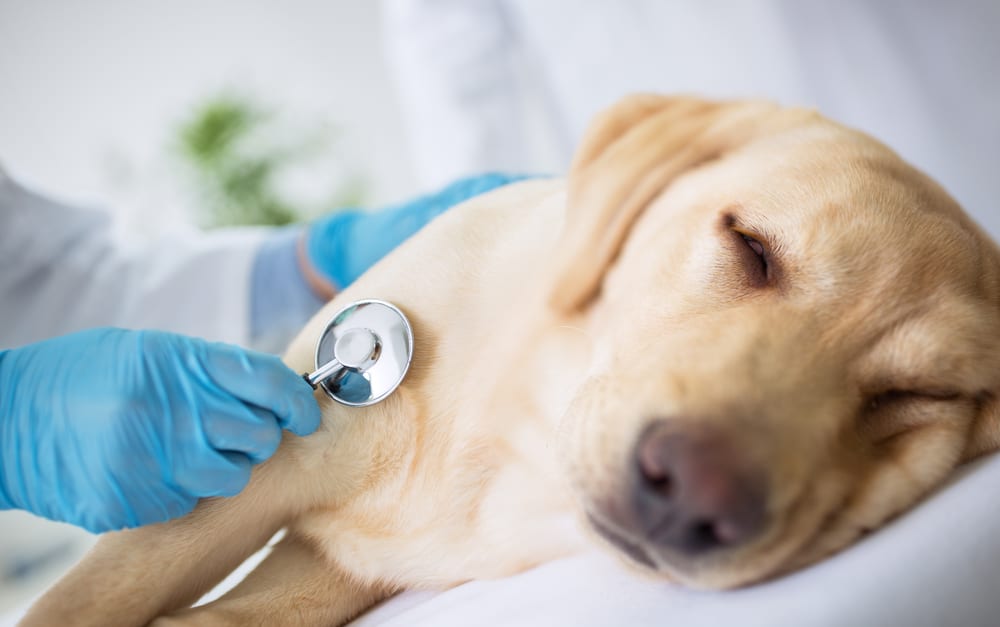The pancreas is a vital organ that is located in the abdominal cavity in close proximity to the dog’s stomach, liver, and small intestine. The pancreas has two main physiological roles: the release of enzymes to aid in digestion and to release hormones that regulate blood sugar. However, certain dietary factors, infection, and toxicity can lead to a condition called pancreatitis. But what is pancreatitis?
Pancreatitis is an inflammatory condition involving swelling of the pancreas, marked with the signs of abdominal pain and vomiting . In dogs, pancreatitis is usually associated with genetics, and dietary issues like fat metabolism, gallstones, and liver disease. Other causes include infectious diseases and toxicity like chocolate toxicity, among others. If you suspect your dog has pancreatitis, contact your vet right away.
Table of Contents
- Anatomy And Physiology Of Pancreas In Dogs
- The Causes And Risk Factors Of Pancreatitis In Dogs
- What Is Triaditis Syndrome?
- What Are The Signs Of Pancreatitis In Dogs?
- Diagnosis Of Pancreatitis
- What Is The Survival Rate Of Pancreatitis In Dogs?
- Do Dogs Need Serious Treatment For Pancreatitis?
- Dietary Adjustment For Treatment And Prevention Of Pancreatitis
- Conclusion: What Is Pancreatitis In Dogs?
Anatomy And Physiology Of Pancreas In Dogs
The pancreas is located in the upper abdominal cavity in close proximity to the stomach, liver, and small intestine (the duodenum part).
The pancreas is a bilobed organ. In close proximity to the proximal duodenum, the right lobe is located in the mesoduodenum.
The left lobe is located in the larger omentum and is situated next to the stomach cranially and the transverse colon caudally. A dorsal pancreatic duct and a ventral pancreatic duct are the two pancreatic ducts that are generally present in dogs.
Exocrine Cells
The duct cells of the exocrine tissue of the pancreas produce water, bicarbonate, chloride, intrinsic factor, and antimicrobial proteins, while the acinar cells produce digesting enzymes like lipases, which are involved in fat metabolism, amylase (digests carbs), and proteases (digests proteins).
Endocrine Cells
Isolated cell clusters called islets of langerhans are all across the pancreatic parenchyma. These islets constitute the endocrine portion of the pancreas, which means they produce hormones.
Islets of langerhans produce three key hormones: glucagon, insulin, and somatostatin. These are synthesized by three types of specialized endocrine cells.
Endocrine Function Of The Pancreas
Insulin and glucagon regulate blood sugar levels in a healthy dog. These two hormones are released by beta cells in the pancreas and are released whenever the level of glucose fluctuates in the blood.
Glucagon
Glucagon is released when the glucose levels drop in the blood, which is called hypoglycemia. It converts the carbohydrate reserves in the liver and muscle (glycogen) and converts it into glucose to maintain the blood sugar concentration. Normal blood glucose in dogs is 80 to 120 mg/dl.
Insulin
The body releases insulin in response to high blood glucose. It increases the utilization of glucose by cells and thus maintains a normal blood glucose concentration.
Somatostatin
Somatostatin has inhibitory effects on endocrine and exocrine function of the pancreas. It prevents the release of pancreatic hormones, such as insulin, in the pancreas. Finally, it decreases gastric secretion and the release of gastrointestinal (GI) hormones, including secretin and gastrin in the GI tract.
The Causes And Risk Factors Of Pancreatitis In Dogs
Pancreatitis is, by definition, an inflammation of the pancreatic tissue accompanied by edema, necrosis, and sometimes hemorrhage.There are a number of causes and risk factors that can lead to this condition in dogs. Here’s what they are.
Dietary Indiscretion
This is a medical term that defines an unusual eating behavior in dogs characterized by eating stuff other than dog food. For instance, eating cardboard or table scrap, junk food, and more can be a sign of this eating behavior. This sudden influx of poorly digested unhealthy food poses a risk of developing inflammation in the pancreas.
A Diet High In Fat
An unbalanced diet with a high-fat proportion can cause pancreatitis. High proportions of triglycerides in the pancreas lead to excessive lipolysis, which releases a large number of free fatty acids.
Normally, these free fatty acids would be absorbed and/or bound to albumin, which effectively eliminates their potential reactivity. However, if the quantity of free fatty acids exceeds the binding capacity of the albumin, then the unbound free fatty acids would be very toxic to the tissues.
Obesity
Similar to a high-fat diet, obesity is a risk factor for developing pancreatitis. Free fatty acids damage the pancreatic parenchyma, resulting in necrosis.
Hypothyroidism
Hypothyroidism, a condition in which the thyroid gland does not produce enough hormones, can cause pancreatitis in dogs due to the presence of high levels of triglycerides in the blood.
This occurs because thyroid hormones help regulate the metabolism of fats in the body, and when there is a deficiency of these hormones, the metabolism of fats gets disrupted, leading to an accumulation of triglycerides in the blood. This accumulation can cause inflammation in the pancreas, leading to pancreatitis.
Additionally, hypothyroidism can also lead to weight gain and obesity, which are also previously mentioned risk factors for pancreatitis in dogs.
Hyperadrenocorticism
Also known as Cushing’s disease in which the adrenal glands overproduce the hormone, cortisol, it increases lipolysis (lysis of fat). This releases a surge of fatty acids that can harm the pancreatic tissue. This also predisposes a dog to develop obesity.
Infectious Agents
Infectious agents can cause pancreatitis in dogs by directly affecting the pancreas or by triggering an immune response that leads to inflammation in the pancreas. Some examples of infectious agents that can cause pancreatitis in dogs include the following:
- Canine parvovirus, adenovirus, and coronavirus can cause pancreatitis in dogs.
- Bacterial infections such as salmonella, E.coli, and brucella canis cause pancreatitis directly or indirectly.
- Parasites such as echinococcus granulosus, toxoplasma gondii, and leishmania can infect the pancreas and cause inflammation. Fungal infections such as aspergillus and candida can do the same.
Toxins And Drugs
Certain toxins and toxic metabolites can cause serious cellular injury to the pancreas and disrupt the enzymatic and endocrine function of the pancreas.
For instance, chocolate contains theobromine, which is toxic to dogs even in small doses. For example, a dog weighing 50 pounds can show signs of toxicity by consuming just one ounce of chocolate.
Other than that, the high fat and sugar content of chocolate can have deleterious effects on the pancreas. Moreover, drugs like cholinesterase inhibitors, salicylates, and phenobarbitals can have toxic effects that affect the pancreas.
Genetics
Lastly, the genetic predisposition to developing pancreatitis is seen in some dog breeds like Yorkshire Terriers, Cocker Spaniels, Dachshunds, and poodles.
Pathogenesis Of Pancreatitis
Pancreatitis develops in response to a series of complex events resulting in cellular damage to the pancreas. Ischemia (decreased blood flow and oxygen to cells) may lead to worsening inflammation and parenchymal damage.
The end result of the multifactorial, intricate process known as pancreatitis is the improper activation of zymogens (proenzymes) within the pancreatic parenchyma.
After zymogen activation, damage from free radicals (like lipid peroxidation) and endothelial membrane damage (like increased capillary permeability) are enhanced.
Pancreatic edema, reduced microvascular flow, the buildup of free radicals, and localized oxidative stress resulting in ischemia further damage the pancreatic parenchyma (the functional tissue).
What Is Triaditis Syndrome?
Triaditis is the concurrent inflammation of three interconnected organs, namely the liver (hepatitis), intestines (enteritis), and pancreas (pancreatitis). Triaditis is more commonly seen in felines than in canines. Infectious agents like viruses, bacteria, and toxins can cause triaditis.
What Are The Signs Of Pancreatitis In Dogs?
Pancreatitis in dogs can show signs like profuse vomiting, abdominal pain and swelling, indigestion, and diarrhea. Mild cases of acute pancreatitis may also present themselves as unexplained anorexia (lack of appetite). In more severe cases, dogs can show signs of colic (abdominal pain) and increased heart rate (tachycardia) and may collapse due to shock.
If you observe any of the aforementioned signs, contact your veterinarian immediately.
Diagnosis Of Pancreatitis

Pancreatitis is diagnosed by careful assessment of history, most importantly the diet and feeding behavior. Secondly, a proper physical exam is conducted, taking into account any recent changes in body weight and condition. Thirdly, the clinical signs of vomiting and abdominal pain can indicate pancreatitis as well.
However, these signs are common in other disease conditions and often are misleading. Therefore, a complete blood count, serum biochemistry, and ultrasonography is recommended in reaching a diagnosis of pancreatitis.
What Is The Survival Rate Of Pancreatitis In Dogs?
The survival rate depends on a number of factors, like age, the severity of the disease, early diagnosis, and dietary adjustment.
Generally, those cases that are acute but of mild-to-moderate nature are self-limiting and get better with supportive care. Other more severe cases need a prompt diagnosis to treat the specific cause of the disease. Also, in some cases, surgery is needed.
Sadly, complicated cases of pancreatitis can lead to cardiogenic shock and multi-organ failure, resulting in death. According to one study, the mortality rate of acute severe pancreatitis is around 27% to 58% in dogs.
Do Dogs Need Serious Treatment For Pancreatitis?
As discussed earlier, the severity of the disease, specific cause, and possible complications should be taken into account before planning for treatment. Also, the treatment should be decided by your veterinarian.
More severe cases of Pancreatitis often warrant therapeutic measures involving fluid resuscitation, supportive medication, antibiotics to fight secondary bacterial infections, and antiemetics to control vomiting.
Surgical approaches are necessary in case of complications involving other vital organs and in cases of pancreatic abscessation and infection.
Dietary Adjustment For Treatment And Prevention Of Pancreatitis
Pancreatitis can be a fatal disease in dogs, but it can be prevented with some dietary adjustments.
A diet low in fat can prevent the risk of damage to pancreatic tissue and thus improve the quality of life of our pet. Fat content of less than 18% is recommended. Also, some veterinarians suggest feeding less than 8% fat to pancreatic patient dogs. As always, consult with your veterinarian about this.
Regardless, this diet can be achieved by feeding your dog specifically formulated food for dogs with pancreatitis or by choosing a diet that is low in fat and high in protein. Some veterinarians also recommend feeding smaller, more frequent meals rather than one or two large meals per day.
Another crucial step is to maintain a healthy weight, as obesity is a risk factor for pancreatitis.
Moreover, avoid feeding table scraps or other high-fat foods to your dog, as this can contribute to the development of pancreatitis. Consult with your veterinarian before making any changes to your dog’s diet.
Conclusion: What Is Pancreatitis In Dogs?
So, pancreatitis isn’t good for dogs to deal with, but it can be prevented and treated. The best thing to do is to keep a close eye on your dog and contact your veterinarian if you notice anything out of the norm.
So, are you noticing signs of pancreatitis in your dog? Have you dealt with it in the past? Let us know in the comments below!
